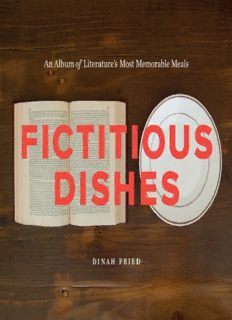
Fictitious Dishes: An Album of Literature's Most Memorable Meals PDF
Preview Fictitious Dishes: An Album of Literature's Most Memorable Meals
DEDICATION For Joe EPIGRAPH I ate them like salad, books were my sandwich for lunch, my tiffin and dinner and midnight munch. I tore out the pages, ate them with salt, doused them with relish, gnawed on the bindings, turned the chapters with my tongue! Books by the dozen, the score and the billion. I carried so many home I was hunchbacked for years. Philosophy, art history, politics, social science, the poem, the essay, the grandiose play, you name ’em, I ate ’em. –RAY BRADBURY, FAHRENHEIT 451, 1953 CONTENTS Dedication Epigraph Introduction The Dishes Moby-Dick; or the Whale On the Road Swann’s Way Little Women The Secret Garden Gulliver’s Travels The Corrections Lolita Rebecca The Bluest Eye The Adventures of Huckleberry Finn The Namesake The Talented Mr. Ripley Hopscotch Gone with the Wind The Catcher in the Rye Beezus and Ramona Robinson Crusoe A Wrinkle in Time One Hundred Years of Solitude The Road Madame Bovary Blueberries for Sal To Kill a Mockingbird “Chicken Soup with Rice” Fear and Loathing in Las Vegas Heidi Middlesex East of Eden The Metamorphosis “Big Two-Hearted River” The Girl with the Dragon Tattoo American Psycho Anne of Green Gables The Bell Jar Oliver Twist Alice’s Adventures in Wonderland The Amazing Adventures of Kavalier and Clay Bread and Jam for Frances Heartburn The Great Gatsby Gravity’s Rainbow A Confederacy of Dunces To the Lighthouse The Tale of Peter Rabbit The Lion, the Witch and the Wardrobe Motherless Brooklyn Emma Valley of the Dolls Ulysses Book Summaries Bibliography Acknowledgments About the Author Copyright About the Publisher INTRODUCTION Many of my most vivid memories from books are of the meals the characters eat. I read Heidi more than twenty years ago, but I can still taste the golden, cheesy toast that her grandfather serves her, and I can still feel the anticipation and comfort she experiences as she watches him prepare it over the open fire. I remember some meals for the moment they signify within a story: the minty cupcakes that Melissa gives to Chip in The Corrections—a marker of their love affair, which causes Chip’s professional downfall and general unraveling. Other meals have stayed with me for the atmosphere they help convey. Recently, a friend told me that after reading Lolita, he began to drink gin and pineapple juice, a favorite combination of the novel’s narrator, Humbert Humbert. I read Lolita when I was barely older than Lolita herself and was amazed that my friend’s description of the cocktail catapulted me back to the distinct world that Nabokov had created: a sticky New England summer when an intoxicated, lust- lorn Humbert Humbert mows the unruly lawn in the hot sun, pining for Dolores, who is away at camp. Likewise, Melville’s description of steaming chowder in Moby-Dick evokes a vision of Ishmael’s seafaring life: salty, damp ocean air on a dark evening; finding solace in a cozy, warmly lit inn with a toasty dining room filled with good cheer and the rich smell of fresh seafood. Reading and eating are natural companions, and they’ve got a lot in common. Reading is consumption. Eating is consumption. Both are comforting, nourishing, restorative, relaxing, and mostly enjoyable. They can energize you or put you to sleep. Heavy books and heavy meals both require a period of intense digestion. Just as reading great novels can transport you to another time and place, meals—good and bad ones alike—can conjure scenes very far away from your kitchen table. Some of my favorite meals convey stories of origin and tradition; as a voracious reader, I devour my favorite books. Which brings me to Fictitious Dishes. The book began a couple of years ago as a small design project while I was at the Rhode Island School of Design. I had the idea to cook, style, and photograph memorable meals I had read about in novels. I had a camera and a rickety tripod, a Whole Foods gift card, a cupboard full of mismatched dishes, and a fast-approaching deadline. After taking the first photos—Oliver Twist, The Catcher in the Rye, Moby-Dick, Alice’s Adventures in Wonderland, and The Girl with the Dragon Tattoo—I was completely hooked on the whole process. There were so many more books to read, so many more meals to make. The project had to continue; I had to keep going, and I did, long past the assignment’s due date. The result is the book you have in your hands. Fictitious Dishes has challenged me to cook outside of my comfort zone. An almost-vegetarian, I never dreamed I’d find myself at my local butcher, asking for a pig kidney (for Ulysses) or pulling apart a week-old chicken carcass (for The Amazing Adventures of Kavalier and Clay). I cooked bananas eleven ways (for Gravity’s Rainbow), including several failed attempts to mold them into the shape of a lion rampant; learned how to make Turkish delight from scratch (for The Lion, the Witch and the Wardrobe); and made my first apple pie ever (for On the Road). Though I’m generally quite squeamish about old food, I collected weeks’ worth of rotting scraps (for The Metamorphosis).
Description: